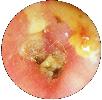II. Epidemiology
- Accounts for 10% of Acute Otitis Externa cases
- More common cause of Chronic Otitis Externa cases
III. Etiology
-
Aspergillus niger (80 to 90% of cases)
- Black exudate
- Candida albicans (second most common cause)
- Cheesy white exudate
- Actinomyces
- Trichophyton
IV. Risk Factors
- Extremely moist, hot environments
- Chronic Bacterial Otitis Externa
V. Symptoms
- Significant Ear canal pruritus more than pain
- Sensation of ear fullness
- Protracted course of Otitis Externa
VII. Differential Diagnosis
VIII. Labs
-
Potassium Hydroxide (10% KOH)
- Fungal hyphae on slide
IX. Management
- See Otitis Externa for General measures (Ear toilet)
- Cleaning and debriding ear is paramount
- Otitis Externa Topical Medications
- Ear Canal Acidification
- Otic Acetic Acid 2% qid for 5 to 7 days
- Alcohol and White Vinegar 1:1 mix as drops in ear
- Topical Antifungals
- Indicated if acidification not effective
- Preparations: Intact Tympanic Membrane
- Clotrimazole 1% (Lotrimin) drops 3-4 times daily for 10-14 days or until resolved
- M-cresyl acetate (Cresylate)
- Preparation: Tympanic Membrane Perforation
- Tolnaftate 1% Solution (Tinactin)
- Systemic Antifungal
- Indicated for refractory Aspergillus infection
- Preparation: Itraconazole (Sporanox)
- Ear Canal Acidification
- Oral Analgesics for 48 hours
X. Prevention: Keep ears dry
- Instill Alcohol in both ears and let drain qhs
- Apply moisturizing cream to edge of ear canal in AM

